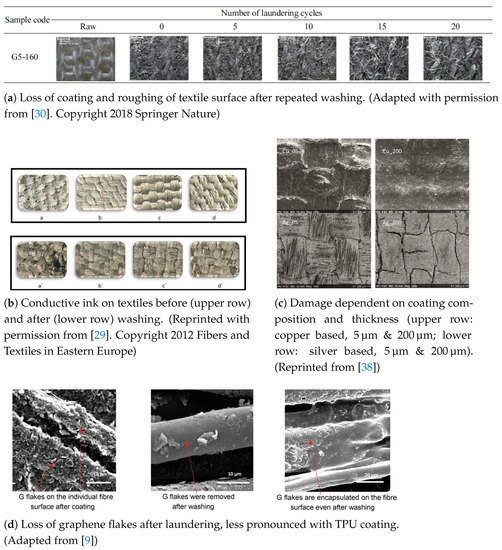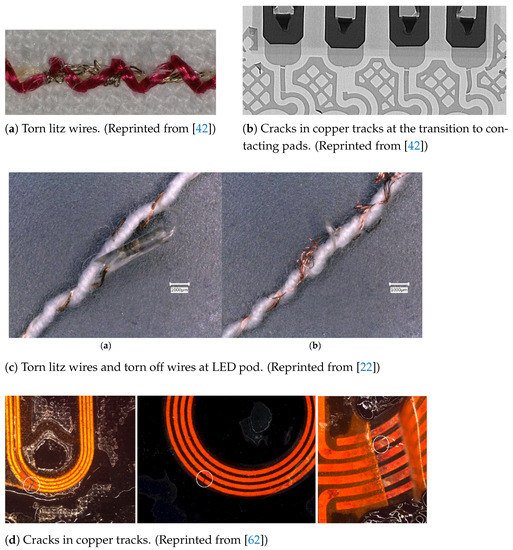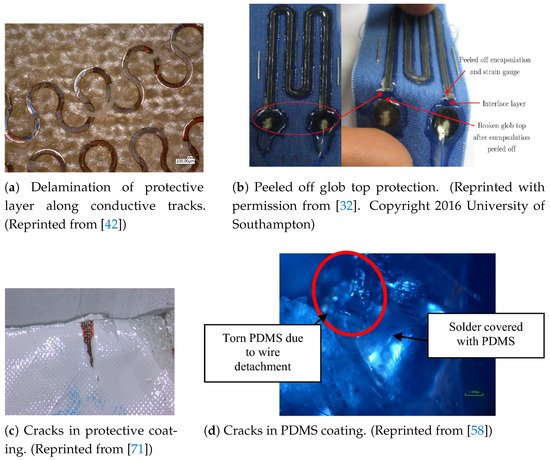
| Version | Summary | Created by | Modification | Content Size | Created at | Operation |
|---|---|---|---|---|---|---|
| 1 | Sigrid Rotzler | + 3037 word(s) | 3037 | 2021-05-24 10:50:19 | | | |
| 2 | Vivi Li | Meta information modification | 3037 | 2021-05-25 10:20:31 | | |
Video Upload Options
E-textiles, hybrid products that incorporate electronic functionality into textiles, often need to withstand washing procedures to ensure textile typical usability. Yet, the washability—which is essential for many e-textile applications like medical or sports due to hygiene requirements—is often still insufficient. The influence factors for washing damage in textile integrated electronics as well as common weak points are not extensively researched, which makes a targeted approach to improve washability in e-textiles difficult.
1. Introduction and Context
2. Effects of Washing on E-Textiles
3. Washing Related E-Textile Failure Modes
3.1. Damages to Conductive Coatings and Printed Conductive Structures

3.2. Damages to Metallization Layers

3.3. Damages to Wires, Conductive Tracks and Connections


3.4. Damages to Protective Layers
3.5. Textile Changes
3.6. Other Failures
3.7. Summary of Failure Modes
4. Conclusion
This article provides an extensive overview of common damage types in e-textiles as a result of (repeated) washing. Although not without limitations, the findings provide much needed insight into how washing affects e-textiles. In doing so, this article can serve as a basis to tackle the pressing matter of washability from different angles and, thereby, create more reliable e-textiles. While some of the findings are applicable to most e-textiles, others are only valid for a specific type of textile-integrated electronics. For a future in-depth approach towards reliably washable e-textiles, a more differentiated examination will thus be necessary, discerning conductor and substrate materials and their requirements as well as the specific e-textile application more thoroughly than this relatively general overview. To achieve this, it will not be sufficient to access, in some cases, the very limited existing sources—as was done in this review. Instead specific, targeted research into single aspects of e-textile washability needs to be conducted.
References
- Rotzler, S.; Kallmayer, C.; Dils, C.; von Krshiwoblozki, M.; Bauer, U.; Schneider-Ramelow, M. Improving the washability of smart textiles: Influence of different washing conditions on textile integrated conductor tracks. J. Text. Inst. 2020, 111, 1766–1777.
- Yole Développment. Wearables in Consumer and Medical Applications 2020; Techreport; Yole Développment: Lyon, France, 2020.
- Rotzler, S.; von Krshiwoblozki, M.; Schneider-Ramelow, M. Washability of e-textiles: Current testing practices and the need for standardization. Text. Res. J. 2021.
- Wagner, G. Waschmittel, 5th ed.; Wiley VCH: Weinheim, Germany, 2017.
- Ellmer, K. Wäsche-Cluster in Konsumentenhaushalten. Ph.D. Thesis, Technische Universität Berlin, Berlin, Germany, 2016.
- Afroj, S.; Tan, S.; Abdelkader, A.M.; Novoselov, K.S.; Karim, N. Highly Conductive, Scalable, and Machine Washable Graphene-Based E-Textiles for Multifunctional Wearable Electronic Applications. Adv. Funct. Mater. 2020, 2000293.
- Ankhili, A.; Tao, X.; Cochrane, C.; Coulon, D.; Koncar, V. Washable and Reliable Textile Electrodes Embedded into Underwear Fabric for Electrocardiography (ECG) Monitoring. Materials 2018, 11, 256.
- Ankhili, A.; uz Zaman, S.; Tao, X.; Cochrane, C.; Koncar, V.; Coulon, D. Washable embroidered textile electrodes for long-term electrocardiography monitoring. Text. Leather Rev. 2019, 2, 126–135.
- Baribina, N.; Baltina, I.; Oks, A. Application of additional coating for conductive yarns protection against washing. Key Eng. Mater. 2018, 762, 396–401.
- Berglund, M.E.; Coughlin, J.; Gioberto, G.; Dunne, L.E. Washability of E-Textile Stretch Sensors and Sensor Insulation. In ISWC ’14: Proceedings of the 2014 ACM International Symposium on Wearable Computers; Association for Computing Machinery: New York, NY, USA, 2014; pp. 127–128.
- Choi, C.M.; Kwon, S.N.; Na, S.I. Conductive PEDOT:PSS-coated poly-paraphenylene terephthalamide thread for highly durable electronic textiles. J. Ind. Eng. Chem. 2017, 50, 155–161.
- Du, D.; Tang, Z.; Ouyang, J. Highly washable e-textile prepared by ultrasonic nanosoldering of carbon nanotubes onto polymer fibers. J. Mater. Chem. C 2018, 6, 883–889.
- Erdem, D.; Yeşilpınar, S.; Şenol, Y. Design of a TENS knee pad with integrated textile electrodes. In Proceedings of the 7th International Technical Textiles Congress, Izmir, Turkey, 10–12 October 2018; pp. 237–245.
- Frank, E.; Bauch, V. Hochfunktionale leitfähige Beschichtungen aus CNT/Polypyrrol-Kompositbeschichtungen für Intelligente Textilien; Resreport; Institut für Textilchemie und Chemiefasern, Deutsche Institute für Textil- und Faserforschung: Denkendorf, Germany, 2013.
- Foerster, P. Untersuchungen zu Eigenschaften von Nanosilberschichten auf Polyamidfasern; Studienarbeit, Technische Universität Berlin: Berlin, Germany, 2010.
- Gaubert, V.; Gidik, H.; Bodart, N.; Koncar, V. Investigating the Impact of Washing Cycles on Silver-Plated Textile Electrodes: A Complete Study. Sensors 2020, 20, 1739.
- Gerhold, L. Researches on Ultrasonic-Welded Electrical Interconnections at Smart Textiles Using Nonconductive Adhesives. Master’s Thesis, Hochschule für Technik und Wirtschaft HTW Berlin, Berlin, Germany, 2018.
- Guo, Y.; Otley, M.T.; Li, M.; Zhang, X.; Sinha, S.; Triech, G.M.; Sotzing, G.A. PEDOT:PSS ‘Wires’ Printed on Textile for Wearable Electronics. ACS Appl. Mater. Interfaces 2016.
- Hardy, D.A.; Rahemtulla, Z.; Satharasinghe, A.; Shahidi, A.; Oliveira, C.; Anastasopoulos, I.; Nashed, M.N.; Kgatuke, M.; Komolafe, A.; Torah, R.; et al. Wash Testing of Electronic Yarn. Materials 2020, 13, 1228.
- Hirman, M.; Navratil, J.; Steiner, F.; Hamacek, A. Effect of Washing Cycles on Glued Conductive Joints Used on Stretchable Smart Textile Ribbons. In Proceedings of the 2020 IEEE 8th Electronics System-Integration Technology Conference (ESTC), Tonsberg, Norway, 15–18 September 2020; pp. 1–4.
- Huang, T.H.; Tao, X.; Ko, Y.C.; Hsu, P.C.; Shen, C.L.; Chen, F.L.; Wang, W.C.; Jou, G.T.; Koncar, V. A Novel Design of E-Textile Integration for Physiological Monitoring and Lighting. J. Fash. Technol. Text. Eng. 2018, S4, 10.
- Hwang, B.; Lund, A.; Tian, Y.; Darabi, S.; Müller, C. Machine-Washable Conductive Silk Yarns with a Composite Coating of Ag Nanowires and PEDOT:PSS. ACS Appl. Mater. Interfaces 2020, 12, 27537–27544.
- Islam, G.M.N.; Collie, S.; Qasim, M.; Ali, M.A. Highly Stretchable and Flexible Melt Spun Thermoplastic Conductive Yarns for Smart Textiles. Nanomaterials 2020, 10, 2324.
- Ismar, E.; uz Zaman, S.; Bahadir, S.K.; Kalaoglu, F.; Koncar, V. Seam Strength and Washability of Silver Coated Polyamide Yarns. In 18th World Textile Conference (AUTEX 2018); IOP Publishing: Istanbul, Turkey, 2018; Volume 460, p. 012053.
- Kayacan, O.; Kayacan, Ö.; Bulgun, E.; Eser, B.; Pamuk, M. Design Methodology and Performance Studies of a flexible Electrotextile Surface. Autex Res. J. 2015, 15, 153–157.
- Kazani, I.; Hertleer, C.; Mey, G.D.; Schwarz, A.; Guxho, G.; van Langenhove, L. Electrical Conductive Textiles Obtained by Screen Printing. Fibers Text. East. Eur. 2012, 1, 57–63.
- Kim, H.; Lee, S. Evaluation of Laundering Durability of Electro-conductive Textile Dip-coated on Para Aramid Knit with Graphene/Waterborne Polyurethane Composite. Fibers Polym. 2018, 19, 2351–2358.
- Kivanc, U.; Bahadir, S.K. Effects of Home Laundering on Electrical Resistance of Signal Transmission Lines on Colored E-Textiles. J. Energy Power Eng. 2017, 11, 336–344.
- Komolafe, A. Reliability and Interconnections for Printed Circuits on Fabric. Ph.D. Thesis, University of Southhampton, Southhampton, UK, 2016.
- Kye, M.J.; Cho, J.; Yu, J.C.; Chang, Y.W.; Han, J.; Lee, E.; Lim, H.S.; Lim, J.A. “Drop-on-textile” patternable aqueous PEDOT composite ink providing highly stretchable and wash-resistant electrodes for electronic textiles. Dye. Pigment. 2018.
- Lee, J.C.; Lo, C.; Chen, C.C.; Liu, W. Laundering Reliability of Electrically Conductive Fabrics for E-Textile Applications. In Proceedings of the 2019 IEEE 69th Electronic Components and Technology Conference (ECTC), Las Vegas, NV, USA, 28–31 May 2019; pp. 1826–1832.
- Li, Q.; Tao, X.M. Three-dimensionally deformable, highly stretchable, permeable, durable and washable fabric circuit boards. Proc. R. Soc. A 2014, 470, 20140472.
- Liu, X.; Guo, R.; Shi, Y.; Deng, L.; Li, Y. Durable, Washable, and Flexible Conductive PET Fabrics Designed by Fiber Interfacial Molecular Engineering. Macromol. Mater. Eng. 2016, 301, 1383–1389.
- Linz, T. Analysis of Failure Mechanisms of Machine Embroidered Electrical Contacts and Solutions for Improved Reliability. Ph.D. Thesis, Universiteit Gent, Gent, Belgium, 2012.
- Malm, V.; Seoane, F.; Nierstrasz, V. Characterisation of Electrical and Stiffness Properties of Conductive Textile Coatings with Metal Flake-Shaped Fillers. Materials 2019, 12, 3537.
- Molla, M.T.I.; Compton, C.; Dunne, L.E. Launderability of Surface-Insulated Cut and Sew E-Textiles. In ISWC ’18: Proceedings of the 2018 ACM International Symposium on Wearable Computers; Association for Computing Machinery: New York, NY, USA, 2018; pp. 104–111.
- Parkova, I.; Viļumsone, A. Insulation of flexible light emitting display for smart clothing. WIT Trans. Built Environ. 2014, 137.
- Paul, G.; Torah, R.; Yang, K.; Beeby, S.; Tudor, J. An investigation into the durability of screen-printed conductive tracks on textiles. Meas. Sci. Technol. 2014, 25, 025006.
- Rotzler, S. Einfluss der Sinnerschen Faktoren Sowie der Textilen Substrate auf die Waschbarkeit Textilintegrierter Leiterbahnen. Master’s Thesis, Hochschule für Technik und Wirtschaft HTW Berlin, Berlin, Germany, 2018.
- Schwarz, A. Electro-Conductive Yarns: Their Development, Characterization and Applications. Ph.D. Thesis, Universiteit Gent, Gent, Belgium, 2011.
- Shahariar, H.; Kim, I.; Soewardiman, H.; Jur, J.S. Inkjet Printing of Reactive Silver Ink on Textiles. ACS Appl. Mater. Interfaces 2019, 11, 6208–6216.
- Shahariar, H.; Kim, I.; Bhakta, R.; Jur, J.S. Direct-write Printing Process of Conductive Paste on Fiber Bulks for Wearable Textile Heaters. Smart Mater. Struct. 2020.
- Tadesse, M.G.; Loghin, C.; Chen, Y.; Wang, L.; Catalin, D.; Nierstrasz, V. Effect of liquid immersion of PEDOT: PSS-coated polyester fabric on surface resistance and wettability. Smart Mater. Struct. 2017, 26, 065016.
- Tadesse, M.G.; Mengistie, D.A.; Chen, Y.; Wang, L.; Loghin, C.; Nierstrasz, V. Electrically conductive highly elastic polyamide/lycra fabric treated with PEDOT:PSS and polyurethane. J. Mater. Sci. 2019, 54, 9591–9602.
- Tang, Z.; Yao, D.; Du, D.; Ouyang, J. Highly machine-washable e-textiles with highstrain sensitivity and high thermal conduction. J. Mater. Chem. C 2020, 8, 2741–2748.
- Tao, X.; Koncar, V.; Huang, T.H.; Shen, C.L.; Ko, Y.C.; Jou, G.T. How to Make Reliable, Washable, and Wearable Textronic Devices. Sensors 2017, 17, 673.
- Uz Zaman, S.; Tao, X.; Cochrane, C.; Koncar, V. Market readiness of smart textile structures—Reliability and washability. In Proceedings of the Aegean International Textile and Advanced Engineering Conference (AITAE2018), Mytilene, Greece, 5–7 September 2018; IOP Publishing: Bristol, UK, 2018; Volume 459, p. 012071.
- Uz Zaman, S.; Tao, X.; Cochrane, C.; Koncar, V. Launderability of Conductive Polymer Yarns Used for Connections of E-textile Modules: Mechanical Stresses. Fibers Polym. 2019, 20, 2355–2366.
- Uz Zaman, S.; Tao, X.; Cochrane, C.; Koncar, V. Understanding the Washing Damage to Textile ECG Dry Skin Electrodes, Embroidered and Fabric-Based; set up of Equivalent Laboratory Tests. Sensors 2020, 20, 1272.
- Xu, B.; Eike, R.J.; Cliett, A.; Ni, L.; Cloud, R.; Li, Y. Durability testing of electronic textile surface resistivity and textile antenna performance. Text. Res. J. 2019, 89, 3708–3721.
- Yokus, M.A.; Foote, R.; Jur, J.S. Printed Stretchable Interconnects for Smart Garments: Design, Fabrication, and Characterization. IEEE Sens. J. 2016, 16, 7967–7976.
- Zeagler, C.; Audy, S.; Gilliland, S.; Starner, T. Can I Wash It?: The Effect of Washing Conductive Materials Used in Making Textile Based Wearable Electronic Interfaces; Techreport; Georgia Institute of Technology: Atlanta, GA, USA, 2013.
- Gui, H.; Tan, S.; Wang, Q.; Yu, Y.; Liu, F.; Lin, J.; Liu, J. Spraying printing of liquid metal electronics on various clothes to compose wearable functional device. Sci. China Technol. Sci. 2017, 60, 306–316.
- Komolafe, A.; Torah, R.; Wei, Y.; Nunes-Matos, H.; Li, M.; Hardy, D.A.; Dias, T.; Tudor, M.; Beeby, S. Integrating Flexible Filament Circuits for E-Textile Applications. Adv. Mater. Technol. 2019, 4, 1900176.
- Ojuroye, O.; Torah, R.; Beeby, S. Modified PDMS packaging of sensory e-textile circuit microsystems for improved robustness with washing. Microsyst. Technol. 2019.
- Satharasinghe, A.; Hughes-Riley, T.; Dias, T. Wearable and Washable Photovoltaic Fabrics. In Proceedings of the 36th European Photovoltaic Solar Energy Conference and Exhibition. EU PVSEC, Marseille, France, 9–13 September 2019; pp. 42–45.
- Tao, X.; Huang, T.H.; Shen, C.L.; Ko, Y.C.; Jou, G.T.; Koncar, V. Bluetooth Low Energy-Based Washable Wearable Activity Motion and Electrocardiogram Textronic Monitoring and Communicating System. Adv. Mater. Technol. 2018, 1700309.
- Vervust, T.; Buyle, G.; Bossuyt, F.; Vanfleteren, J. Integration of stretchable and washable electronic modules for smart textile applications. J. Text. Inst. 2012, 103, 1127–1138.
- Veske, P.; Bauwens, P.; Bossuyt, F.; Sterken, T.; Vanfleteren, J. Development and Washing Reliability Testing of a Stretchable Circuit on Knit Fabric. Appl. Sci. 2020, 10, 9057.
- Björninen, T.; Virkki, J.; Sydänheimo, L.; Ukkonen, L. Impact of Recurrent Washing on the Performance of Electro-textile UHF RFID Tags. In Proceedings of the 2014 IEEE RFID Technology and Applications Conference (RFID-TA), Tampere, Finland, 8–9 September 2014; pp. 251–255.
- Cai, L.; Song, A.Y.; Wu, P.; Hsu, P.C.; Peng, Y.; Chen, J.; Liu, C.; Catrysse, P.B.; Liu, Y.; Yang, A.; et al. Warming up human body by nanoporous metallized polyethylene textile. Nat. Commun. 2017, 8, 496.
- Dhanawansha, K.B.; Senadeera, R.; Gunathilake, S.S.; Dassanayake, B.S. Silver nanowire-containing wearable thermogenic smart textiles with washing stability. Adv. Nano Res. 2020, 9, 123–131.
- Fu, Y.Y.; Chan, Y.L.; Yang, M.H.; Chan, Y.C.; Virkki, J.; Björninen, T.; Sydänheimo, L.; Ukkonen, L. Experimental Study on the Washing Durability of Electro-Textile UHF RFID Tags. IEEE Antennas Wirel. Propag. Lett. 2015, 14, 466–469.
- Kazani, I.; Declerq, F.; Scarpello, M.L.; Hertleer, C.; Rogier, H.; Vande Ginste, D.; Mey, G.D.; Guxho, G.; van Langenhove, L. Performance study of screen-printed textils antennas after repeated washing. Autex Res. J. 2014, 14, 47–54.
- Martinez-Estrada, M.; Moradi, B.; Fernández-Garcia, R.; Gil, I. Impact of Manufacturing Variability and Washing on Embroidery Textile Sensors. Sensors 2018, 18, 3824.
- Quandt, B.M.; Braun, F.; Ferrario, D.; Rossi, R.M.; Scheel-Sailer, A.; Wolf, M.; Bona, G.L.; Hufenus, R.; Scherer, L.J.; Boesel, L.F. Body-monitoring with photonic textiles: A reflective heartbeat sensor based on polymer optical fibres. Interface 2017, 14, 20170060.
- Virkki, J.; Björninen, T.; Kellomäki, T.; Merilampi, S.; Shafiq, I.; Ukkonen, L.; Sydänheimo, L.; Chan, Y. Reliability of washable wearable screen printed UHF RFID tags. Microelectron. Reliab. 2014, 54, 840–846.
- Wang, S.; Chong, N.L.; Virkki, J.; Björninen, T.; Sydänheimo, L.; Ukkonen, L. Towards Washable Electrotextile UHF RFID Tags: Reliability Study of Epoxy-Coated Copper Fabric Antennas. Int. J. Antenn. Propag. 2015, 2015, 424150.
- Zhao, Z.; Yan, C.; Liu, Z.; Fu, X.; Peng, L.M.; Hu, Y.; Zheng, Z. Machine-Washable Textile Triboelectric Nanogenerators for Effective Human Respiratory Monitoring through Loom Weaving of Metallic Yarns. Adv. Mater. 2016, 28, 10267–10274.




